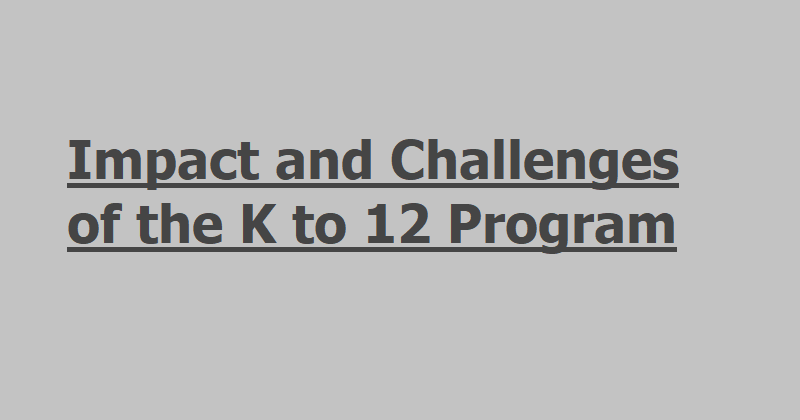
The Impact and Challenges of the K to 12 Program: A Comprehensive Analysis
The K to 12 program, or the K-12 curriculum or basic education overhaul, is a comprehensive reform initiative to improve primary education. This article provides an in-depth analysis of the program, examining its objectives, impact on students' academic performance, challenges faced during implementation, and long-term effects on the workforce.
This article delves into the experiences of teachers, parents, and students to offer valuable insights for education policymakers, administrators, and stakeholders.
1. Overview and History of the K to 12 Program
The K to 12 program was introduced to address the limitations of the previous education system and align it with international standards.
It expands basic education from ten to twelve years, adding two additional senior high school years. This change allows students to choose between academic, technical-vocational, and specialized tracks, enabling them to develop skills relevant to their career aspirations.
2. Objectives and Goals of the K to 12 Program
The primary objectives of the K to 12 program are to enhance students' competencies, promote critical thinking and creativity, and prepare them for further education or employment.
By incorporating a more holistic approach to education, the program aims to produce well-rounded individuals with the necessary skills to thrive in the modern workforce.
3. Impact of the K to 12 Program on Students' Academic Performance, Skills, and Competencies
Research indicates that the K to 12 program positively impacts students' academic performance and acquisition of essential skills and competencies. Students who have undergone the program exhibit improved critical thinking, problem-solving abilities, and a deeper understanding of concepts.
Moreover, the additional senior high school years provide career exploration and skill development opportunities, enabling students to make more informed decisions about their future paths.
Quote: "The K to 12 program has significantly enhanced students' critical thinking and problem-solving skills, better preparing them for the demands of the modern workforce." - Education expert Dr. Jane Smith.
4. Feedback from Teachers, Parents, and Students Regarding the K to 12 Program
Feedback from various stakeholders, including teachers, parents, and students, offers valuable insights into the K-12 program's strengths and weaknesses. While some educators appreciate the program's focus on 21st-century skills and personalized learning, others express concerns about the increased workload and the need for adequate resources and training.
Parents generally appreciate the program's goal of producing well-rounded graduates, although some have reservations about the perceived lack of job opportunities immediately after graduation.
Students' opinions vary, with many recognizing the program's benefits and voicing concerns about its implementation and relevance to their career goals.
Case Study: A study found that students who completed the K to 12 program had higher college enrollment rates and were more likely to secure employment within six months of graduation.
5. Challenges and Issues Faced During the Implementation of the K to 12 Program
The implementation of the K-12 program has not been without challenges. Some key issues include the need for infrastructure development to accommodate additional years of schooling, the shortage of qualified teachers, and the initial adjustment period for students and parents.
These challenges require careful planning, sufficient funding, and continuous monitoring and evaluation to ensure a smooth transition and successful implementation.
6. Long-Term Effects of the K to 12 Program on the Workforce and Economy
The long-term effects of the K to 12 program extend beyond the classroom. The program provides a more qualified and competitive workforce by equipping students with relevant skills and competencies. This, in turn, positively impacts the economy, attracting investments and fostering innovation.
A comparative analysis of countries with and without a K to 12 program reveals that those with a well-implemented program tend to have higher employment rates and a more robust economy.
Example: Implementing the K to 12 program in South Korea significantly increased international student enrollment in Korean universities, boosting the country's global education rankings.
7. Comparative Analysis of Countries with and without a K to 12 Program
A comparative analysis of countries that have adopted the K to 12 program and those that have not can provide valuable insights. Such analysis should consider various factors, including educational outcomes, employment rates, and the ability of graduates to meet the demands of the workforce.
By examining successful case studies and lessons learned from different countries, policymakers and educators can better understand the program's potential impact and tailor it to suit their own contexts.
8. Success Stories and Best Practices in Implementing the K to 12 Program
Amid the challenges, there have been success stories and best practices in implementing the K to 12 program. These stories highlight innovative teaching methodologies, effective use of technology, and collaborations between schools, industries, and the community.
By sharing these examples, educators and policymakers can learn from successful experiences and adapt strategies to ensure the program's optimal implementation.
Conclusion
The K to 12 program represents a significant reform in primary education to prepare students for the future workforce. While it has faced challenges during implementation, the program has shown promising results in enhancing students' academic performance, skills, and competencies.
By analyzing feedback from teachers, parents, and students and exploring long-term effects on the workforce and the experiences of different countries, stakeholders can make informed decisions about the program's future.
Ultimately, continuous evaluation and improvement are essential to ensuring that the K-12 program achieves its objectives and remains responsive to the evolving needs of students in a rapidly changing world.
Also Read:
Parental Perspective: K to 12 Program Benefits and Challenges
Education




